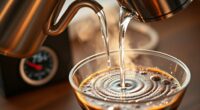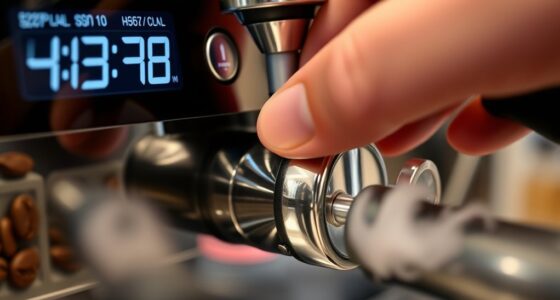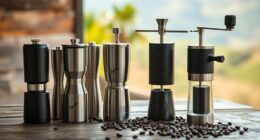Understanding pressure profiling on lever machines means learning how to control and adjust water pressure during extraction to improve flavor, consistency, and overall espresso quality. You’ll start by calibrating your machine and gradually adjusting pressure throughout the shot, influencing extraction and taste. The process involves monitoring gauges, practicing control, and refining your technique. Keep experimenting and paying attention to your results—this will guide you toward mastering pressure profiles for better espresso shots.
Key Takeaways
- Pressure profiling involves adjusting extraction pressure during brewing to influence flavor and consistency on lever espresso machines.
- Proper calibration of pressure sensors ensures accurate readings for effective pressure control.
- Techniques include gradual pressure adjustments and monitoring gauges to shape the pressure curve during extraction.
- Customizing pressure profiles helps optimize flavor extraction, prevent over-extraction, and improve overall shot quality.
- Developing manual control skills and consistent workflows is essential for mastering pressure profiling on lever machines.
What Is Pressure Profiling and How Does It Work?
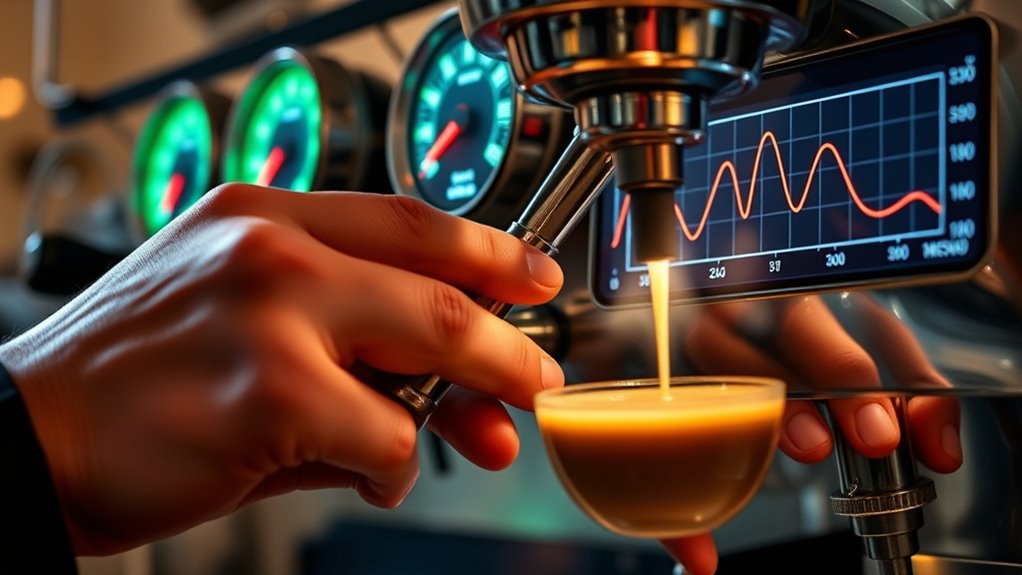
Pressure profiling is a technique used to monitor and control the extraction process on lever espresso machines. It involves adjusting the pressure applied during extraction to influence flavor and consistency. As a barista, mastering pressure profiling requires refined techniques and precise machine calibration. By carefully manipulating the pressure curve, you can highlight specific flavor notes or smooth out undesirable bitterness. Proper calibration guarantees your machine responds accurately to your adjustments, making pressure profiling more effective. Understanding the importance of temperature control in relation to pressure adjustments helps optimize extraction and flavor development. This technique demands attention to detail and a good understanding of your equipment’s capabilities. When done correctly, pressure profiling allows you to tailor each shot to produce a balanced, high-quality espresso. It’s a skill that elevates your craft and gives you control over your final brew.
The Benefits of Customizing Pressure During Extraction
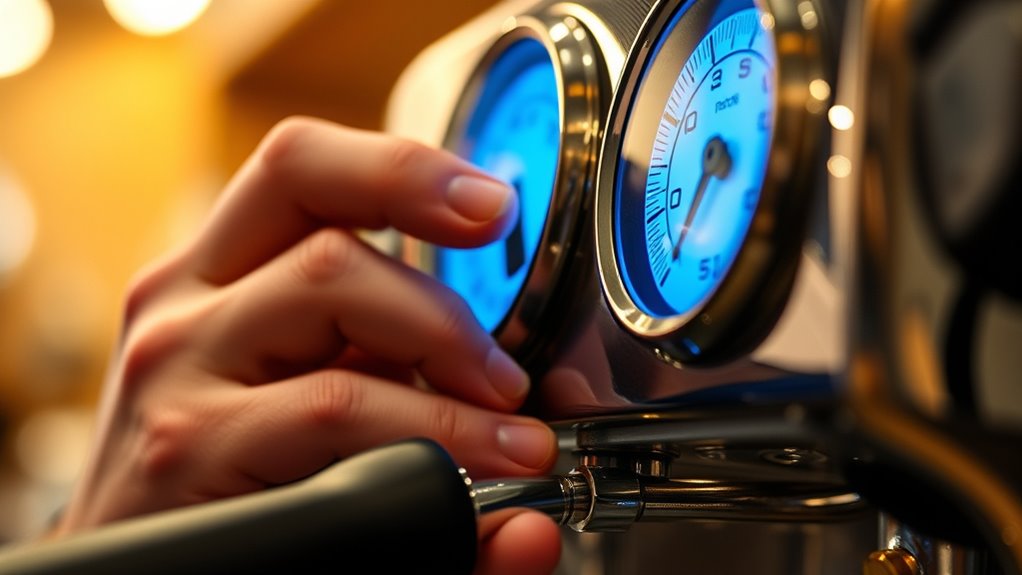
By customizing pressure during extraction, you can open up richer flavors and achieve a more balanced taste. It also helps you maintain consistent brews and avoid over-extraction that can lead to bitterness. Adjusting pressure gives you greater control over each shot, ensuring ideal results every time. Understanding the contrast ratio of your equipment can further enhance the visual clarity and depth of your display.
Enhances Flavor Extraction
Customizing pressure during extraction allows you to open a richer and more complex flavor profile in your coffee. By adjusting pressure, you influence how the grind size and water temperature interact, revealing nuanced tastes. Here are three ways this enhances flavor extraction:
- Fine-tuning grind size to match pressure levels ensures ideal extraction of oils and flavors without over-extraction.
- Modulating water temperature during pressure adjustments helps extract delicate aromatics and reduces bitterness.
- Tailoring pressure profiles allows you to highlight specific flavor notes, creating a balanced, vibrant cup.
- Precise pressure control can also extend the lifespan of your machine by reducing wear and tear on components.
Through pressure profiling, you maximize how your coffee interacts with grind size and water temperature, resulting in a more flavorful, aromatic brew that truly reflects your preferences.
Controls Brew Consistency
When you adjust the pressure profile during extraction, you gain greater control over brew consistency. By fine-tuning pressure, you can compensate for variations in grind size and tamp pressure, ensuring each shot remains uniform. A consistent grind size helps maintain the right flow rate, while adjusting pressure prevents over- or under-extraction. Custom pressure profiles allow you to adapt to different beans and roast levels, reducing variability between shots. This control means you don’t have to rely solely on grind size or tamp pressure alone, giving you a more reliable way to produce balanced, high-quality espresso every time. Additionally, understanding pressure profiling techniques can further enhance your ability to customize and perfect your brew. Ultimately, customizing pressure during extraction helps you achieve repeatable results, making your brewing process more precise and your coffee more consistent.
Prevents Over-Extraction
Adjusting the pressure profile during extraction helps prevent over-extraction by controlling the flow rate and contact time between water and coffee. When pressure is stable, you maintain better extraction balance, avoiding excessive solubilization of undesirable compounds. This customization allows you to fine-tune the process, ensuring ideal flavor clarity. Additionally, understanding the cookie categories involved helps optimize your settings for a better brewing experience.
Key Factors Influencing Pressure Profiles
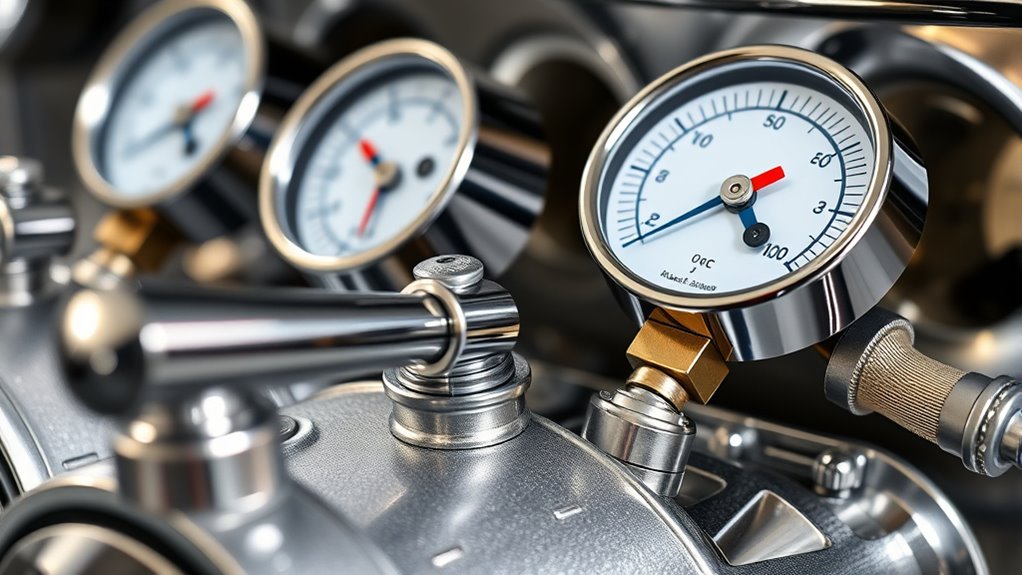
Your brew method critically impacts the pressure profile you need to achieve ideal extraction. Adjusting machine configuration settings also plays a vital role in shaping how pressure builds and releases during brewing. Understanding these key factors helps you tailor pressure profiles to match your desired flavor outcome. Incorporating kitchen textiles and accessories such as aprons or dish towels can also influence your workflow efficiency, ensuring a smoother brewing process.
Brew Method Impact
The brew method you choose considerably influences the pressure profile on a lever machine. Your approach affects pressure dynamics, which directly impacts extraction optimization. Different methods, such as pre-infusion, ramping, or steady pressure, shape the pressure curve uniquely. Incorporating pressure control techniques can further refine extraction and flavor clarity.
Machine Configuration Settings
Machine configuration settings play a crucial role in shaping the pressure profile during a brew, directly affecting extraction quality. Your water temperature influences the brewing process; higher temperatures can increase pressure, while lower temps may produce a gentler profile. Proper grinder calibration ensures consistent grind size, which impacts resistance and pressure buildup. When your grinder produces uniform, appropriately sized grounds, you create predictable pressure curves. Adjusting water temperature and maintaining precise grinder calibration allow you to fine-tune the pressure profile to suit your taste and bean type. Small changes in these settings can lead to significant differences in extraction, highlighting their importance. By carefully managing these factors, you gain better control over your lever machine’s pressure behavior, ultimately improving your espresso’s flavor and consistency. Regularly monitoring and adjusting these parameters can also help in achieving optimal pressure profiles, leading to a more consistent and high-quality brew.
Techniques for Implementing Pressure Profiling on a Lever Machine
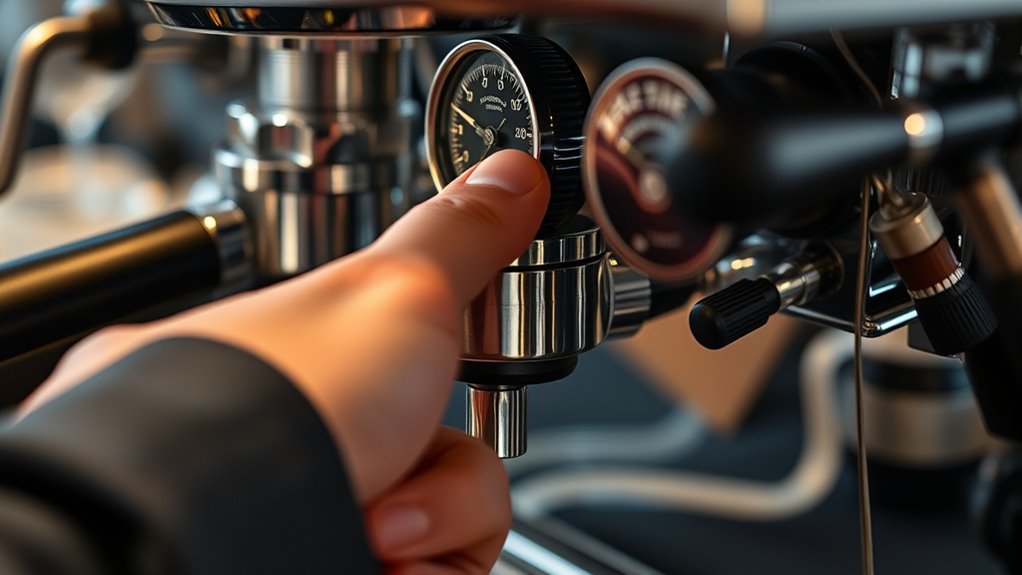
Implementing pressure profiling on a lever machine involves carefully controlling the pressure applied throughout the extraction process. To do this effectively, you need to understand pressure dynamics and master lever calibration. Here are key techniques:
Master lever calibration and gradual adjustments to perfect pressure profiling.
- Start with consistent lever calibration to ensure your pressure application matches desired profiles.
- Adjust the lever gradually during extraction, varying pressure at specific intervals to shape the shot.
- Monitor pressure gauges closely, making small, controlled movements to maintain precise pressure levels.
Common Challenges and How to Overcome Them
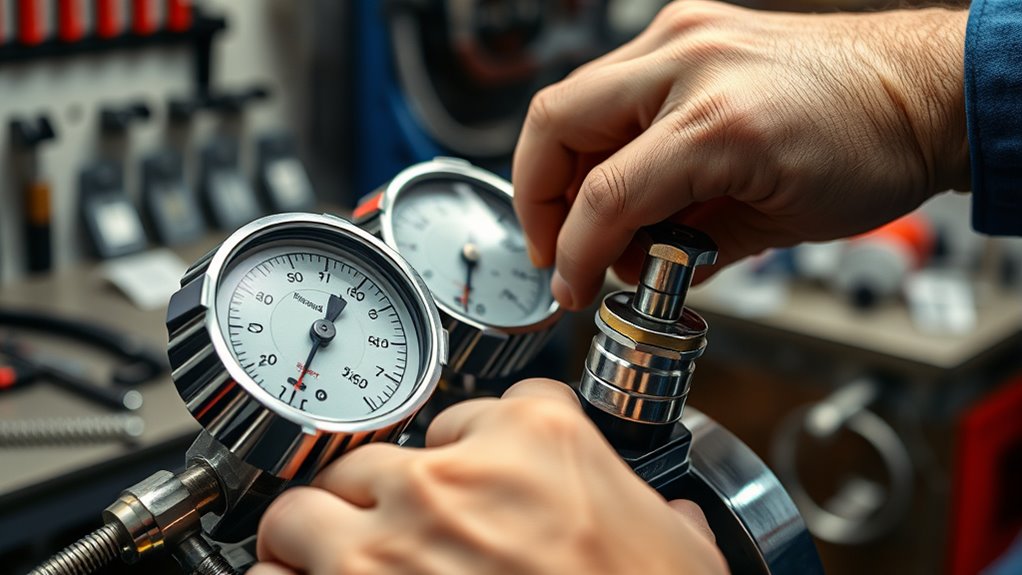
Despite careful planning, pressure profiling on a lever machine can present several challenges. One common issue is accurately reading the pressure sensor, which may fluctuate or give inconsistent readings. This makes it harder to maintain a steady profile. Another challenge is mastering manual control; it requires a steady hand and experience to adjust pressure smoothly without abrupt changes. Inconsistent pressure application can lead to uneven extraction and compromised flavor. To overcome these problems, verify your pressure sensor is calibrated regularly for accurate readings. Practice controlling the lever steadily, focusing on gradual, consistent pressure adjustments. Using the correct headphone jacks can help ensure clear communication and monitoring during espresso extraction. Patience and experience are key. By refining your manual control skills and verifying your equipment, you’ll improve your pressure profiling and achieve better coffee consistency.
Tips for Practicing and Perfecting Your Pressure Profiles
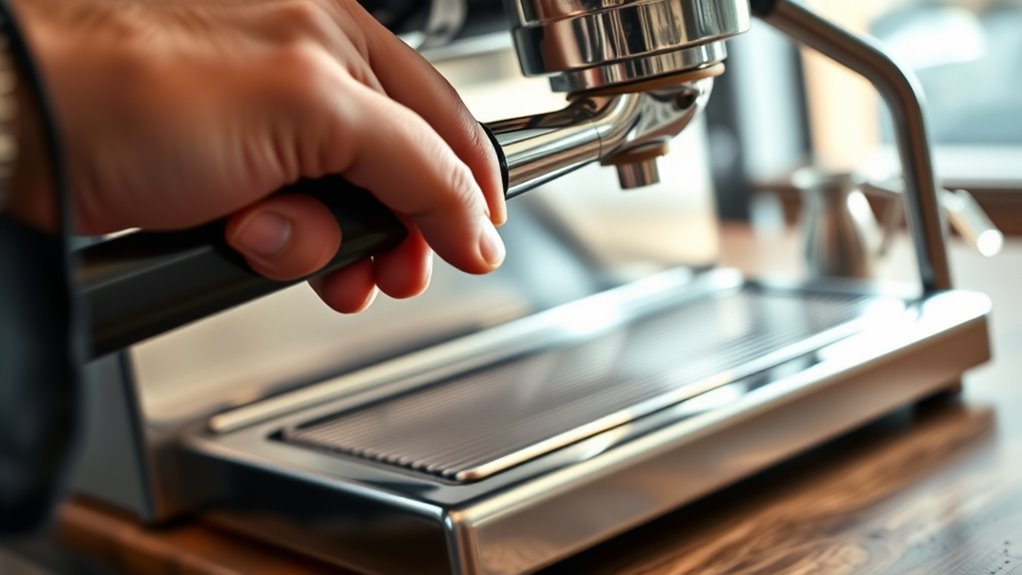
Practicing regularly is essential for mastering pressure profiling on a lever machine. To refine your skills, focus on three key areas:
- Adjust your grind size: Finer grinds increase resistance, helping you better control pressure buildup and release during extraction.
- Vary tamp pressure: Experiment with different tamp pressures to see how they affect pressure curves and flavor extraction.
- Record your profiles: Use a pressure gauge to track your pressure curves and identify patterns or inconsistencies.
- Understand the role of somatic therapy techniques: Incorporating body awareness practices can help you develop a more intuitive connection with your machine, enhancing your ability to make precise adjustments.
Consistently practicing these steps will help you develop a feel for your machine and shot timing. Over time, you’ll intuitively adjust grind size and tamp pressure to produce balanced, optimized shots.
Frequently Asked Questions
How Does Pressure Profiling Affect Coffee Flavor Development?
Pressure profiling affects your coffee flavor development by allowing you to control pressure consistency during extraction. When you adjust the pressure profile, you influence how flavors are extracted from the coffee grounds, leading to a more balanced and complex cup. By fine-tuning pressure, you optimize flavor extraction, enhancing the richness and brightness of your brew. This precise control helps you craft a more nuanced and personalized coffee experience.
Can Pressure Profiling Be Automated on Lever Machines?
You can automate pressure profiling on lever machines by integrating sensors that monitor pressure in real-time, allowing for precise manual adjustments. This setup enables you to create consistent profiles without continuously manually controlling the lever. With sensor integration, you can program specific pressure curves, ensuring that each shot matches your desired profile. Automating pressure profiling enhances consistency and precision, making it easier to achieve ideal extraction and flavor development.
What Equipment Is Needed to Measure Pressure Accurately?
Imagine you’re trying to read the heartbeat of your espresso machine. To do this, you need precise pressure sensors that can detect the subtle changes during extraction. Pair these with a data logging device that records the pressure over time. This combination allows you to measure pressure accurately, giving you the insights needed to optimize your brew and guarantee consistency every time you pull a shot.
How Do Different Coffee Beans Respond to Pressure Changes?
You’ll notice that different coffee bean characteristics, like density and oil content, influence their pressure sensitivity during extraction. Lighter or more fragile beans tend to require gentler pressure changes, while denser beans can handle higher pressure profiles. By observing how your beans respond to pressure adjustments, you can fine-tune your technique to enhance flavor extraction, ensuring each brew highlights the unique qualities of the coffee.
Is Pressure Profiling Suitable for All Types of Espresso Machines?
Imagine revealing the full potential of your espresso shot—pressure profiling might be the key. But is it suitable for your machine? It depends on machine compatibility and your user expertise. Not all espresso machines can handle custom pressure adjustments, making some profiles impossible. If you’re new to advanced techniques, you might struggle. Yet, if your machine supports it and you’re confident, pressure profiling can elevate your brewing game dramatically.
Conclusion
Mastering pressure profiling on your lever machine is like tuning a fine instrument—you’ll reveal richer flavors and a more soulful espresso. With patience and practice, you’ll craft profiles that dance in harmony with your beans, elevating every shot. Remember, each adjustment is a brushstroke on your coffee canvas. Keep experimenting, stay curious, and soon you’ll find your perfect rhythm, turning your machine into an extension of your passion and artistry.

